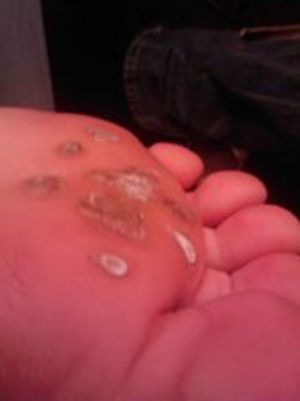Plantar warts are unlike common or flat warts in that they do not rest on top of the skin, but right underneath the skin. They also grow in painfully awkward places like the soles of your feet and the palms of your hands. They are common and treatable, but you do have to go to a doctor if you want fast, effective treatment. Over the counter remedies tend not to work for plantar warts at all. They usually go away on their own after a couple of painful months.
Causes
All warts are caused by the same source the human papillomavirus (HPV). There are thought to be over a 100 different variations, which only differ in telling your body where to grow warts. HPV is highly contagious but not fatal. There is no cure for HPV only in suppressing the warts. Once you contract HPV, your body tends to grow warts until it’s able to get used to it.
This is one reason why children are the most often effected by warts such as plantar warts; they don’t have a natural immunity to it yet. It thrives in warm, moist places.
The way you contract the HPV for plantar warts is often like this: Someone with HPV walks through puddles, such as in a public swimming pool or gym. You have a cut on your foot. You walk through the same puddle. The HPV enters your body through the cut on your foot.
Symptoms
You know you have plantar warts when you feel as if pebbles are always in your hands or feet. When plantar warts are on the soles of your feet, even wearing socks is impossible, let alone walking. Your painful body parts will at first look unchanged but they will feel changed.
Eventually, callus-like growths will appear on the soles of your feet or the palms of your hand. They can be flat or grainy and sometimes are gray or black in color. The gray or black coloring is often mistaken for HPV “seeds”, but they are actually the points of swollen, clotted blood vessels.
Plantar warts often become very itchy, but try not to scratch. If you manage to open your skin, then the HPV will spread to other parts of your body. Some people find that a cold pack or a heating pad can help ease the itch.
Conventional Treatments
Most of the time, plantar warts can be diagnosed by a doctor with just a glance, but sometimes a scalpel scraping might need to be done in order to come to a correct diagnosis. Plantar warts bleed in a distinctive “pinpoint” way that calluses, corns or other skin growths don’t.
There are three common kinds of conventional medical treatments for plantar warts, which can often be performed in a doctor or podiatrist’s office:
Salicylic acid : This chemically burns off the plantar warts. There are some 40% salicylic acid patches made that you can buy in pharmacies, but many people find them painful (especially if they don’t follow the directions exactly).
Cryotherapy (freezing): The plantar warts are frozen off with liquid nitrogen. If the plantar warts have not erupted to the skin surface, then the area must be surgically opened under general anesthesia. This is one of the least painful treatments for plantar warts, especially for small children.
Minor surgery: One of the fastest ways for getting rid of really deep set plantar warts is through surgery. The area is opened and the warts are fried off by electrodessication (use of an electric needle). There is also laser surgery, but that is far more expensive.
Medications may also be prescribed, depending on how stubborn the infection is. You might be prescribed antibiotics if any surgery is involved.
Any alternative treatment should be used in conjunction with and not a replacement of your doctor or podiatrist’s advice. Some people have found these treatments work for really stubborn cases of plantar warts. Alternative treatments include:
Duct tape: You completely cover your plantar warts with duct tape and change the “bandage” once a day. It is thought that the duct tape cuts off oxygen to the site, therefore killing the warts. A study in 2002 showed that 85% of patients were healed with duct tape while only 60% were healed by cryotherapy.
Apple Cider Vinegar: Soak clean cotton packing or cotton balls in apple coder vinegar, cover with a clean bandage and then affix them to your skin with medical tape. Change every day.
Heating pad: Set the heating pad to 122 degrees Farenheight (50 degrees C) and wear on the painful area for 30 seconds four times a day.
References:
Mayo Clinic. “Plantar Warts.”
eMedicine. “Plantar Warts.”
Science Daily. Science Reference “Plantar Wart.”
CBSNews.com “Duct Tape Therapy.” Bootie Cosgrove-Mather. Feb. 11, 2009.
Reference:
- www.podiatrychannel.com/plantarwarts/index.shtml
- www.howtogetridofstuff.com/health/how-to-get-rid-of-plantar-warts/
- doctor.webmd.com/physician_finder/home.aspx?sponsor=core
